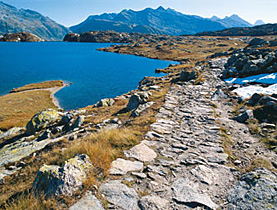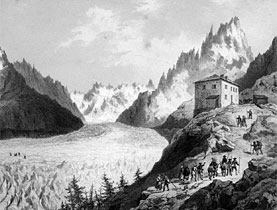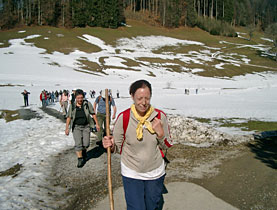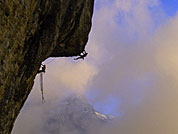Swiss slow travel concept wins global award

Following in the footsteps of the tortoise that beat the hare, a Swiss institution has won an international award for its innovative approach to slow travel.
At the annual Alpine Convention conference held in Evian, France, last week, Cultural Routes of Switzerland was recognised for its outstanding contribution to sustainable tourism. The Swiss tourism programme is a project of ViaStoria, the Center of Transport History.
“We are delighted with this award and hope that it will bring Cultural Routes of Switzerland to the attention of people throughout Europe,” said Hanspeter Schneider, ViaStoria’s director.
Along with Environment Minister Moritz Leuenberger, Schneider was part of the Swiss delegation to the conference. Besides Switzerland, the Alpine Convention includes Austria, France, Germany, Italy, Liechtenstein, Monaco and Slovenia.
The Bern-based organisation took first place in the competition for the Alpine Convention’s sustainable and innovative tourism project award. Five additional projects from other alpine nations were also praised.
“We’ve already noticed an increase in interest in our work,” said ViaStoria’s communications officer Caroline Süess, just days after the award was presented.
Living history
Established in 2003 as a Bern University spin-off, ViaStoria has three primary goals: to research and to protect Switzerland’s historical transit routes, and to promote their respectful use.
As a key project of ViaStoria, Cultural Routes of Switzerland promotes slow travel with a focus on history, culture and nature.
Its concept is based on a cross-country network of routes that follow historical paths and roads, linking both cultural and scenic attractions. For example, the ViaGottardo leads from Basel to Chiasso over the famous Gotthard Pass, while the ViaJacobi follows the Constance-to-Geneva portion of the Way of St James, the pilgrim path.
“The trails are the central theme, flanked by local and regional history,” said Süess.
The recommended itineraries involve a mixture of hiking plus travel by train, bus and boat. Travellers are encouraged to sample the local cuisine and to stay in traditional inns and hotels.
For those who wish to tackle the trails independently, there is a wealth of printed guide material available. But Cultural Routes of Switzerland also offers package deals that include meals, accommodation, museum entry and luggage transport.
In the coming year, ViaStoria plans to intensify its cooperation with like-minded international organisations. As concerns about global warming mount, the demand for environmentally-friendly travel options is growing – especially within the Alps.
“It’s our vision to serve in an advisory context. We have the know-how and we want to share that knowledge,” said Süess. As she points out, Switzerland is somewhat of a “pass-through” nation – making cross-border collaboration a logical next step. Indeed, many of the Via-Routes already lead into neighbouring countries.
Educational value
The network of historical trails is a natural fit for primary and secondary school teachers looking to combine education with recreation. With that in mind, the team at ViaStoria is creating learning materials to help young people discover Swiss history right at the source.
“Living insights and experiences are tangible only in direct contact with the world,” said Süess.
Together with the heritage organisation Pro Patria and the Bern and Valais colleges of education, ViaStoria is developing Internet and print resources suitable for students of all ages.
The materials, which will be ready in 2010, can be used to prepare for short excursions as well as for lengthier school trips.
swissinfo, Susan Vogel-Misicka
ViaCook: Geneva – Lucerne – Pontarlier (F)
ViaFrancigena: Pontarlier (F) – Aosta (I)
ViaGottardo: Basel/Schaffhausen – Chiasso
ViaJacobi: Rorschach/Konstanz (D) – Geneva
ViaJura: Basel – Biel
ViaRhenana: Konstanz (D) – Basel
ViaRomana: Geneva – Augst
ViaSalina: Arc-et-Senans (F) – Bern
ViaSbrinz: Stansstad – Ponte (I)
ViaSpluga: Thusis – Chiavenna (I)
ViaStockalper: Leuk – Domodossola (I)
ViaValtellina: Schruns (A) – Tirano (I)
This foundation maintains and supports the diverse aspects of Swiss culture.
It raises money through donations and the sale of patriotic items, including a popular line of special stamps.
In May, new stamps featuring the Cultural Routes of Switzerland will go on sale.
This was the world’s first convention for the protection of a mountain region, and it is binding under international law.
Considered in its geographical continuity, the transnational mountain area is a common territory facing common challenges.

In compliance with the JTI standards
More: SWI swissinfo.ch certified by the Journalism Trust Initiative



You can find an overview of ongoing debates with our journalists here . Please join us!
If you want to start a conversation about a topic raised in this article or want to report factual errors, email us at english@swissinfo.ch.